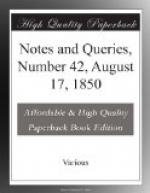“In this part of the
country, her death is attributed to a fall
whilst in the act of picking
an apple from a tree in an orchard
at Drumana.”
In the Olla Podrida, a volume of miscellanies, printed for private distribution, by Mr. Sainthill of Cork, there is a portrait of the “old countess,” from an etching made by Mr. Crofton Croker (if I mistake not) in his early days.
J.M.B.
Michael Servetus, alias Reves.—The manuscript, the character and fate of which S.H. (Vol. ii., p. 153.) is anxious to investigate, contained books iii.-vii., inclusive, of the work of Servetus De Trinitate; and as these fragments differed somewhat from the printed text, they were probably the first, or an early, draft (not necessarily in the author’s handwriting) of part of the Christianismi Restitutio. The purchaser of this MS., at the sale of Du Fay’s library in Paris in the year 1725, was the Count de Hoym, ambassador to France from Poland. I beg to refer your correspondent to pp. 214-18. of the Historia Michaelis Serveti, by Henr. ab Allwoerden, published with Mosheim’s approbation, Helmstad 1728.
Both a “Note” and a “Query” might be founded on a memorable passage in the fifth book De Trinitate, in which Servetus, long before Harvey, explains the circulation of the blood.
R.G.
Caxton’s Printing-office (Vol. ii., pp. 99. 122. 142.).—It is a pity MR. NICHOLS did not take the trouble to see, and, having seen, to notice in his first communication, that Abbot Islip was mentioned in the passage from Stow’s Survey cited by MR. RIMBAULT. As that gentleman quotes from, I believe, the second edition of the Survey, I may be allowed to doubt, until it is clearly shown, that “Islip’s name has been introduced by the error of some subsequent writer.” But supposing this to be so, it would in no way affect the only question which is material, Who was Caxton’s patron? nor touch the accuracy of the Life of Caxton, which MR. NICHOLS seems desirous of impeaching. I am anxious to point this out, because I feel it right to vindicate to the utmost, where they deserve it, useful works, which, like the little volume I am writing of, are published at a price that ensures for them a circulation of almost unlimited extent.
ARUN.
Somagia (Vol. ii., p. 120.).—This is the plural of “somagium,” “summagium,” and means “horse-loads.” It is a word frequently found in documents relating to agrarian matters, and may signify the load packed upon the horse’s back (whence the name “sumpter-horse"), or in a cart drawn by a horse. MR. SANSOM will find a full explanation of the derivatives of its root, “sagma,” at p. 50., vol. vii., of Ducange.
J.BT.
Various Modes of Interment among the Ancients (Vol ii., pp. 8, 9. 22. 41. 78.).—In modes of interment some nations have been distinguished by an idiosyncrasy almost incredible from their inhumanity.




